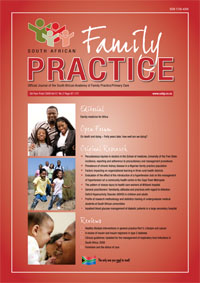The Pattern of Sharps Injury to Health Care Workers at Witbank Hospital
Keywords:
Health care workers, sharps / needlestick injury, blood borne infections
Abstract
Background: The aim of this study was to identify procedures, areas of activity, occupational groups and other variables, which carry a high risk of transmission of blood borne infections from patients to Health Care Workers (HCW) at Witbank Hospital. Method: This was a descriptive - cross sectional study, which was conducted among Health Care Workers of Witbank Hospital, who were directly involved in patient care over the analyzed 2 year period (1.01.03 - 31.12.04). Results: 435 Health Care Workers completed the questionnaires. 46, 7% of respondents had suffered from either needlestick /sharps injury (74, 47%) or contamination of skin/mucous membranes (25, 53%). 76, 9% of all needlestick/sharps injuries were inflicted by injection needles. Taking blood was the most dangerous procedure/activity, being responsible for 29, 56% of all injuries. 44, 61% of injured HCW reported 1 injury, 45, 59% reported 2-3 injuries and 9, 8% were injured more than 3 times. The youngest interviewed group (20-29 years old) was injured most frequently (61, 9%). Professional nurses who are the largest professional group employed at hospital were involved in 41, 38% of all reported injuries. Interns reported the highest rates of injury - 84, 37% of them were injured at least once. Conclusion: This study showed that there is a well-defined pattern of injuries, which can lead to transmission of blood borne infections from patients to Health Care Workers at Witbank Hospital.
Published
2009-03-06
Section
Original Research
By submitting manuscripts to SAFP, authors of original articles are assigning copyright to the South African Academy of Family Physicians. Copyright of review articles are assigned to the Publisher, Medpharm Publications (Pty) Ltd, unless otherwise specified. Authors may use their own work after publication without written permission, provided they acknowledge the original source. Individuals and academic institutions may freely copy and distribute articles published in SAFP for educational and research purposes without obtaining permission.

